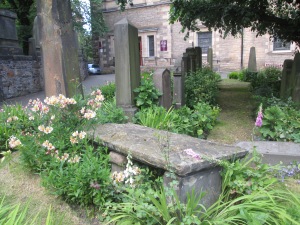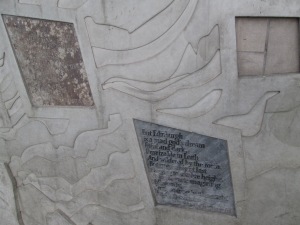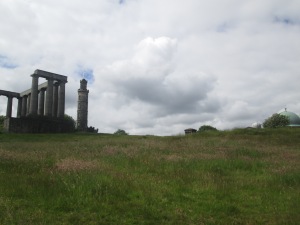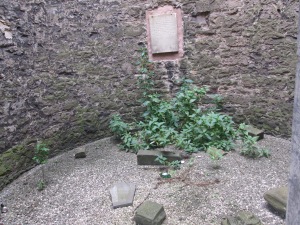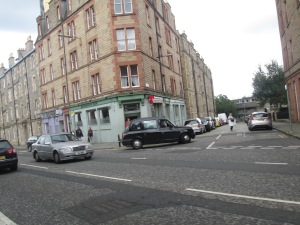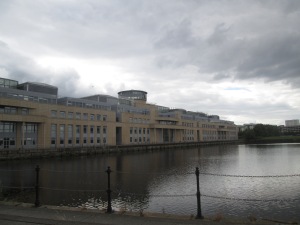‘I’ve been skiving for like, the whole week!’ Young teen to older brother, Tollcross, Edinburgh.
Every part of me had started to ache: knees, legs, heart and head. I needed a few days rest with my partner in some cosy, lovely and friendly town, surrounded by wonderfully sunny weather and friends old and new. Edinburgh has therefore been a gentle delight.
It’s also a city of contrasts. Its historic Georgian town centre just about conceals large and troubling social problems cast out to the suburbs. Its confidence in displaying its own past is undermined by an uncertainty about its future. And for a town that some remark as being the ‘most English’ Scottish town – on account of its seeming gentility perhaps? I’m not sure – the built scenery often reminded me of a Scandinavian or German town, pleasant if somewhat sterile. I’ll try to relay what I’ve found, and I encounter visions of its past and future quite at odds with each other.
I arrived on Tuesday evening and stayed with my friend Josep and his partner Delwar. Their place is a roomy, high-ceilinged tenement flat overlooking the grand Usher Hall and the city’s small business district below. One striking feature about Edinburgh from a distance is its modesty as a city. Aside from the columns of the unfinished National Monument up on Calton Hill, there are no ugly phallic skyscrapers or 1960s jerry-built high-rises disrupting the view. It makes telling Edinburgh apart from the nearby towns it has absorbed quite confusing.
Inside the flat, thick rugs coat the floors and images from Bangladesh elsewhere neatly juxtapose with the view of passing buses and lunching office workers from the large window below. We are by the Clydesdale Bank building which appears on one Scottish note I pick up (the blue, tan and violet colours, with their literary heroes and engineering marvels depicted, are quite unique).
I lock myself in for most of the first day, recuperating and catching up with writing, until my partner arrives in at the Waverley station, an impressively grand station that is easy to navigate and not overrun with TV screens, CCTV threats, food kiosks or advertisements. Seeing her again is wonderful.
For anyone considering a journey of this kind, I suggest arranging to see a loved one on the trip, or returning home for a break. It has given me the strength and hope to carry on and enjoy this strange expedition.
We will spend the next few days wandering about the town centre and relaxing together.
Waverley is situated kind of in between Edinburgh’s New Town and Old Town – a deceptive description as they do look a little similar. Around and to the north of the station are the Georgian developments of the New Town, of a style similar to the West End of London. There is the long Princes Street, a long and dull avenue filled with the most popular of high street chains, and typical of most towns. A series of gridded lanes, squares follow further north and around, with George Street just north being reserved for more exclusive restaurants, hotels, freemasons’ clubs and a rampacked Wetherspoons pub where we stop for a while. Leaving the station and into Princes street, we’re immediately overwhelmed by these historical buildings all about us. There is the lovely Princes Gardens nearby, and a long series of benches where some kind of dedicatory plaque war once raged. Two centuries back, Edinburgh’s authorities placed some kind of literary or historical statue at every available opportunity. The town is very proud and sure of its past greatness.
From Princes Street we cross over the North Bridge and head towards the Old Town. We cross the Royal Mile, where tourists loiter about lost among the cobbles and tartan stores. There’s an alarmingly high number of street beggars all over the town. Most are men between their 20s and 40s, of working age, and obviously quite ill, and drink or drug dependent. I had an image of an affluent and twee city which was perhaps intentional on the part of the city’s tourist campaigns, but the dilapidated roads and obvious presence of poverty disrupts this a little. It makes me wonder what Edinburgh is trying to do to tackle this problem. Drug and alcohol dependency is evident everywhere. Is the town like a prim and proud yet deeply impoverished old relative, desperately hiding its frays and wear in the ostentatious display of its glorious but long-past days?
Avoiding the tourist frenzy, we head further south, eventually stumbling across a Brewdog pub on Cowgate. It’s a cocky brand from Aberdeenshire and with some degree of (admirable?) arrogance, refuses to serve lager. We’re greeted with a local diplomatic reception that trumps even the most ludicrously carnivalesque of royal visits. Three young people and an older woman are sat outside, and the woman immediately falls for Sarah. She shakes Sarah’s hand fiercely and says ‘I love you, you’re beautiful – you’re accepted!’ It turns out she’s been drinking since 10am, and the others a little later. ‘It’s a dive but it’s cheap!’ is Andy’s view on our chosen boozer. It’s neither in my view, but the company’s superb.
They tell us about the best places to drink in Edinburgh, though the instructions are a little confusing. Their accents are thick. Though lubricated by strong local beer, we find what Grace and Andy tell us a little hard to follow – mainly tips on cheap salsa bars to drink in (‘cheap beer but tastes like pish!’), and more compliments about Sarah’s beauty. Their friendliness is overwhelming. Grace complains about the tourists in August as she leaves, vigorously shaking our hands. We drink up our ad agency beers and move on.
Our welcome in Edinburgh stays consistently bright and cheery thereafter. We drift around George Street, passing by a city that doesn’t feel fettered by the burdens of its history. Scots guards, William Pitt, George IV, Adam Smith, David Hume and countless other grand old worthies gaze out from Georgian plinths onto the surrounding traffic. Walter Scott has his very own monument which looks like the spire of a gothic church with his mighty statue and high-domed forehead beneath.
We stop for a pint in the wetherspoons and then head back up north Bridge to an Italian restaurant for dinner, before drifting back to Josep’s and Delwar’s, where we talk late about the city, about our lives, and about the ‘pubic triangle’ of strip joints and massage parlours that surround the American hotels and business offices nearby.
Edinburgh is a tranquil and relatively peaceful town, despite the bustle, and we feel in no mood to rush. The next afternoon we get talking to two women from Huddersfield in a nearby pub, and later, another local Edinburgh woman with the same distinctive but thick accent. They’ve worked as nurses in intensive care, and describe the ‘living dead people’ they come across, ‘almost dying not almost living’. When one’s brother was dying, the job became too difficult and she took to home visits to children.
They’re concerned about the NHS and feel little hope for its future. ‘Before the NHS was fucked up, it was different.’ On my last evening in Edinburgh, I also meet Paul, a nurse for around nineteen years who now has a management post. He tells me similarly that the job has become too stressful. I ask what would help. ‘More money, more budget, more staff, more police, more security.’ None seems forthcoming. With his long experience and retirement hopes, thoughts of a career change are, unfortunately for him, long past.
Pat’s story is also sad, and she talks about losing many of her family to cancer. It looks as if her own brother will soon pass because of the disease. She has a bright and tough spirit, and invites me to her pub to meet a guy from Orkney, an offer I sadly miss out on taking up. For each person we talk to, the prettiness of the town, and of drinking a beer on a late afternoon, each help to lift spirits and minds from the impermanence and painfully uncontrollable events of human existence. As I knock back pints of McEwans, Edinburgh Gold, Belhaven Best and the local brew, Deuchars, whiffs of malt and wheat drift over from the nearby Caledonian brewery.
We adventure on into the ‘Old Town’, wandering by the foot of Castle rock and the series of late-Georgian buildings that today constitute Edinburgh castle. The town takes its name from a Brittonic Celtic Din Eidyn, brown hill fort, which was transformed by old English into Eidyn burh. The ancient rocks, some 340 million years old, dormant volcanoes, looms above the town alongside Calton Hill and Arthur’s Seat to the east, each reminding the town of the proximity and pleasures of the countryside. Beyond the cobbles, the buildings around pretty Grassmarket, Lawnmarket and the Royal Mile seem a little similar to the New Town. They are more cramped and more likely to be interrupted by ill-fitting Scottish Presbyterian Kirks, but the town’s historical centre feels consistent. At Grassmarket we seek out signs of Burke and Hare, the murderous pair who killed at least 17 locals and sold their bodies for dissection at the Edinburgh Medical College. Today there is no sign of their tenement house where this grievous misdeeds occurred, but their notoriety is commemorated in a strip club, where bored dancers squat smoking outside. Nearby is Brodie’s Close, where Deacon Brodie once lived as a peaceful and law-abiding citizen by day, and, to fund his gambling habit, a mischievous burglar by night. Scottish writer R.L. Stevenson found plenty in the life of this strangely Manichean character to pad out Dr Jekyll and Mr Hyde.
We drink around Grassmarket and catch up. We’re later joined by our friend Kirsten, originally hailing from Aberdeen who has also made a home in Edinburgh. She likes the place but wonders, like us, if the town centre is a little too sterile. Despite the massive influx of comedy and theatre acts in August, there are few local music scenes or a sense of countercultural activity in the way one might expect from Nottingham, Glasgow, or for Kirsten, Aberdeen.
Later we eat with Josep, Delwar, and a couple of his friends who also work in academic anthropology. Their experiences of researching across the world are fascinating, but the questions they raise about the nature and customs of human societies are universal, and we find a good deal to talk about. But their experiences are also different, and reflect a different kind of class and education experience. One visitor tells us that she’s not worried about her paper, as she’s a star, with no irony intended. Words slip that the universities me and Sarah are at are ‘rubbish’, not meant with malice but reflecting the growing division of university work between elite, research-based Russell universities with Oxford and Cambridge at the top, and the much wider number of newer universities that heavily focus on teaching, employability, and curry far less academic or cultural prestige. It reminds me of some well-meant advice I received before I left, that I would be better served doing a second PhD at Oxford or Cambridge if I wanted to reach the higher echelons of academic life.
It’s a glimpse into the competitive and mean-spirited attitudes that can surface among the insecure hoping to make a name for themselves as professionals. Empathy, cooperation and disinterested assistance are lost, but as I later raise to Josep, isn’t viewing all this as a ‘game’ both dangerous and misleading? Josep in part agrees, but shares his experiences around men more broadly. Growing up and feeling different, he’s considered male interactions as a kind of game with certain rules to follow. It makes me think about the secret ignorance of football, and other things. Nothing is natural after all.
The next day Sarah and I are about wandering, this time towards the south of Edinburgh around Tollcross. I wonder if there’s a burden of history in these old buildings, many of which are dirty and used as charity shops and takeaways further out. During breakfast at a local bakery where we eat tattie scone rolls and haggis, I ask one local if Edinburgh feels like these historical buildings. It’s a vague question reflecting a half-formed thought, but it feels normal to him.
I can’t help comparing it to Birmingham and London, to the towns of England that aggressively cleared their slums and old buildings after WW2 in a drive to construct a more modern and socially progressive future. The legacy of these 1960s streets in the sky and new towns has been largely negative, but there would have been an opportunity across the 1960s and 70s for the values behind this kind of architecture – and the extra resources needed to maintain these structures – to become socially normalised and loved. Places like Park Hill, or the Robin Hood or Alton estates in London, represented a kind of egalitarian social progress. This seems best represented in the destruction of the perfectly fine Doric arches at Euston station, a perversely brilliant moment in my view. Sometimes traditions need to be exploded for a new kind of civil culture to discover its own power and values. This desire and belief in the future has now largely been lost. As we peek through tourist maps with their immense number of historical monuments, mock-ups and museums, we wonder what a museum of the future would look like.
There are some fine charity shops along Tollcross, and the area has a very multicultural feel, whilst remaining mostly white Scottish. It feels open and accepting. In one shop I find a guidebook with a map, and a copy of Adam Smith’s Wealth of Nations. My phone company has cut off my data supply after over-use, and after Edinburgh I will be dependent on compass and personal directions.
I’ve been additionally blighted by the muscles in my legs completely freezing up, making walking very difficult, particularly up steps. It’s been two days since I last rode the bike, and I receive varying theories on the cause. Lactic acid build-up? Who knows. But wandering around Princes gardens, across St Cuthbert’s cemetery where De Quincey is bured, up the Walter Scott monument and around the national gallery is very painful. There are moments of pleasure too. In the gardens we discover the delights of Irn Bru sorbet, and as we sit back, children tear about chasing weary pigeons across the greens. In the gallery we spot Phill Jupitus in disarmingly casual clobber, gazing at an iPad by Titian’s ‘Venus Rising’, as a camera man preps him on the pithy and enlightened attitudes necessary for fine art commentary. There are many aspirational if dull early modern paintings, of families and court dames, and biblical scenes in secular garb, like Rubens’ delightfully macabre Feast of Herod. There’s a statue of Lavoisier posing poutily in a way David Hume would call ‘luscious’, and nearby are Velazquez’s Blind Woman, a portrait by Rembrandt, and Rodin’s The Kiss. It’s a nice enough gallery but I tend to find more life in the streets and pubs outside.
‘It’s alright here, I don’t think it’s terribly exciting, I just think it’s pretty.’
I agree with Sarah’s verdict, for the town centre at least. But I’m charmed by the city’s confidence in its cultural and intellectual achievements. I haven’t found an English town that venerates its philosophers, economists and engineers with anywhere near the same confidence. Perhaps the Scott monument is the best example of this.
‘Breathes there the man, with soul so dead
Who never to himself has said,
This is my own, my native land!’
Scott’s poetry and prose served to create and unite a ‘Scottish identity’ over a land deeply divided between Highlands and Lowlands, with the bitter histories of the failed Jacobite rebellion and the Highland clearances in recent memory. Scott’s achievement, if it can be called that, was to help generate a national pride that empowered many to consider the union with England an equal one, between two independent states, rather than a subordinate one. It’s worth noting that the Scots only entered the union with England in 1707 after immense economic problems following the Darien scheme during the 1690s. Aiming to to establish a trading colony in Panama, it proved to be an unlucky disaster. Despite lacking the same population, resources and wealth, from 1707 to the early 20th century Scotland contributed much to the establishment of the British Empire and hegemony, from inventions and engineering to staffing the Indian Civil Service.
We follow the life of David Hume, looking in vain for the tenement off Lawnmarket where he was born, and later discovering the house that he lived towards the end of his life at 21 St. David Street, on the south-west of Andrews Square. Hume’s common sense, empirical world view is perhaps the closest historical philosophical position that chimes with our modern views. Hume had little time for gods or grand metaphysical systems. ‘Custom is the great guide of human life’, and our thoughts link together by sense, memory, and its forms of association. He refuses to give into fears about the afterlife, and reinforced philosophy on the track of examining only what could be known. Though much of Hume’s ideas are drawn from John Locke, and to a degree George Berkeley, there’s enough in it to captivate the reader with a passing interest in philosophy. Take this fine line:
‘Survey most nations and most ages. Examine the religious principles, which have, in fact, prevailed in the world. You will scarcely be persuaded, that they are any thing but sick men’s dreams: Or perhaps will regard them more as the playsome whimsies of monkies in human shape, than the serious, positive, dogmatical asseverations of a being, who dignifies himself with the name of rational.’
I am quite the sick man by the end of the day, and take a bath followed by a heavy dousing in Deep Heat to trick my muscles into moving. We have dinner with Kirsten and her partner David in the east end of Edinburgh near Abbeyhill. It’s an opportunity to wander down the commercialised heritage of the Royal Mile, where shops promise to give you your family history for £10, and I lose track of the shops exclusively retailing Princess Diana memorial tartan. We pass an old toll-booth which once charged people to leave the city, forcing many of the poor to never leave Edinburgh’s walls.
Eventually we stumble on the Scottish parliament, a delightful building that feels accessible and open to the public, so unlike Westminster. There are no anti-terrorism barriers or machine guns, no oppressive traditional buildings that retain the style and cultures of English boarding schools. Windows are large and open, and this feels like a place where one might want to turn up to hear a public debate. Under the car-park nearby, the Scottish Presbyterian and Reformation leader John Knox is buried. I’m later told apocryphally that it was a popular gay meeting point, a fact that will delight anyone opposed to the repressive and authoritarian decrees of this church, or others.
Kirsten works as in a public analyst’s office, whilst David splits him time working as a literary pub tour ticket-seller, an assistant at the historic time-capsule of Gladstone’s Land, and working in rural libraries, ex-mining towns where bored kids harass the staff. Many of the towns surrounding Edinburgh like Dalkeith are quite grim, I’m warned.
‘Travel two miles out of the city centre and you’ll see a very different Edinburgh.’
David’s point proves to be quite right. We get a takeaway curry and pop into some the local offies, which sell some extraordinary drinks. We get cans of 4Loco, an alcoholic energy drink banned in the US but freely on sale here. In another store we find cans of Buckfast, the monk-brewed tonic wine popular in the Glasgow suburbs, and often linked to antisocial behaviour. I’m told you can drink it by the pint in Coatbridge Wetherspoons, and on my trip to Glasgow I’ll be seeking out the ‘Buckfast triangle’ by Airdrie.
The next morning we dine on a fine Scottish breakfast of tattie scones and strong black coffee. I look through some Yes campaign materials – a raffle with a car, some leaflets demonstrating Scotland’s pro-business credentials – and ask Kirsten about it. She knows of a few no voters, including people on the left, but they tend to be ‘the less vocal ones.’ I’m told of a clear link between youth and voting yes to independence, but the mood in Edinburgh on the whole is uncertain. The No campaign has a slight lead in the polls, but it is armed by more powerful political allies and a far greater campaign budget. People I meet seem unsure, but feel assured of the inevitability of Scottish independence at some point in the future. As I point out, many people in England, or Wales, or Northern Ireland, are very much opposed to Trident nuclear missiles, the bedroom tax, or any other of the catastrophes inflicted by the UK coalition government.
It’s a Saturday, and Sarah must sadly take the train back home to see the cat and get on with things. It’s sad seeing her off at Waverley and the time has flown, but this journey is of my own making. I hope something great will come of it all. So far, the friends, experiences and ideas found on the road feel promising.
A little melancholy, I wander up Calton Hill to take in the extraordinary views of the city. David Hume later campaigned for the council to build ‘public walks or roads for the health and amusement of the inhabitants’. He’s commemorated in ‘Hume’s walk’ which takes the traveller to the top of the hill, up to the old observatory, Nelson monument, and National Monument that one sees on arriving in Edinburgh.
A few tourists mill about, and I drink in the view, imagining the ghosts of JMW Turner and Jules Verne comparing witty remarks on the grand and meticulously-planned arrangements of the New Town, and the shabbier estates to the north-west. I look out on a flat settlement that stretches out to the Forth of Firth, and wonder where those settlements with peculiar names like Balerno, Joppa and Drem sit. At the bottom of the hill is the cemetery where Hume is buried, his remains housed in a grand secular enclosure of sorts, with cans of cider and bottle of gin strewn inside. Some fool has put up a Christian dedication. Nearby statues point and weathered grave stones tell the stories of the fleeting passage of time.
It’s quite a contrast with the winding road through Princes Street that lo, two miles on, takes one to the impoverished and run-down northern suburbs. I stop in Drylaw to take in the pebbledash semis and get something to eat in a bakery. The girl behind the counter is friendly and is happy with the area, and despite appearances, there are signs of stability and comfort. Further north is the deeply deprived Muirhouse, where unemployment, alcohol and drug misuse have blighted this run-down set of disconnected estates. I pass through the grotty Pennywell arcade where only a tatty pub, betting shop, off-licence and Greggs remain open, the supermarket seemingly closed some time ago. An older man shouts at two young people in familiar tones, but a drunken rage.
I pass through the 1960s arcade and its shuttered shops, reaching a little library and local arts centre. Josep works here, and as he spends time with local children drawing and reading – a chance for them to talk with trusted adults about events in their lives – I peer about the books on Scotland. Nearby, local lads play a football video game supplied by the library. ‘What a fair mess eh?’ says one. They shout, cheer, and fall out with each other.
‘That’s a daft tackle, unnecessary, and now he’s off’, announces the computer’s commentator.
In one book I read about the opening of the Scottish parliament in July 1999 by the Queen. A singer gave a rendition of Robert Burns’s ‘A man’s a man for a’ that. The irreverent lines are funny and worth repeating:
‘Ye see yon birkie [fellow] ca’d a lord,
What struts, and stares, and a’ that;
Though hundreds worship at his word,
He’s but a coof [fool] for a’ that:
For a’ that, and a’ that,
His riband, star, and a’ that,
The man of independent mind,
He looks and laughs at a’ that!’
Josep takes a brief lunch break and we wander a bit around the area, getting a pasty in Gregg’s. There are loads of bored young to mid-teens hanging around the entrance. ‘Excuse me? Weeey’, says one girl to us. As I stand nearby I can’t help hearing one conversation.
‘He was saying that I shagged his brother.’ [Sounds of disappointment].
‘Didye?’
‘Aye, he was a fuckin fag.’
In the library, one lad takes out a lighter and pretends to set alight another’s coat. Another enters and tears about on a BMX, ignoring the staff’s warnings not to do so. I ask Josep if they ever get any trouble there.
‘Some of the kids just lose it. They’re not able to control themselves’.
I ask him what could be done. He points out the activities in the area, like the arts centre, and the work of the library. I tell him about the communal notices I’ve seen for nearby youth centres, drug services, and mental health living well activities. We sit in an outside circle gazing out at an abyss of nothing, distant high-rises and a large green space with nothing in it. Behind is are some garages. There’s nothing here. But Josep thinks that people do have the power to step out of these circumstances and not be determined by them to repeat history. He draws on his own experiences, and I can’t help comparing them with others. But such cycles of poverty are to be escaped only by a prior motivation, and then opportunity, to escape the area.
As I leave, I realise that someone has interfered with my bike. A flask and my bungee rope for fixing my bags on has been nicked. I’d been warned that the previous week one visitor’s bike had been destroyed by the kids for no reason, after he’d popped in to use the computers. I’d left it for little more than half an hour, and luckily had removed all my bags. It leaves a bad taste in my mouth, and I’m glad to leave Muirhouse.
I take Ferry Road towards the east, where I spot my flask again at a bus stop, in the care of a heavily-pished old ‘Jakey’ (local slang for down-and-out alcoholic) who I’d seen earlier in Muirhouse. ‘A wee one left it!’ I don’t believe him, and there are the dregs of cider at the bottom – I think. I think of the bored kids in the area, the easy cash opportunities and escapism of drugs, and the wider abandonment of parental figures and role models. The library struggles to give some sense of order, and displays of kindness, on an otherwise tough estate.
I reach Leith, a port area now absorbed by Edinburgh but still retaining its own independent feel. I see its own library and spot the ugly modernism of the ‘Banana Flats’ in the distance, re-painted after the fruit. The area is by no means as grim since its early 1990s immortalisation by Irvine Welsh, captured in Trainspotting. The largely closed docks have been partly gentrified by posh restaurants, luxury housing, and the ugly Ocean Terminal mall, a great non-place that could be anywhere, filled with familiar high-street brands.
I drift about the area, wondering if this kind of gentrification has done some good to a once heavily deprived district. I pop into the lively Port of Leith pub following a local tip, and soon find myself in very friendly company. I meet Glenn, originally from Kircaldy, who has worked as mail delivery man for nearly two decades. He tells me of the beautiful drive from Edinburgh to Inverness, of how the postal service has been transformed by marketization, and the changes in Leith since he’s lived here.
He’s largely positive about it, and thinks the area’s been improved a lot. Outside investment has done something with buildings and spaces that were largely abandoned. Bad housing and troublesome tenants have been removed, albeit elsewhere, and the area carries a buzz about it attractive to passing visitors. Over pints of Belhaven, we talk about Edinburgh, about football, and eventually about independence, with other locals occasionally chipping in (‘How’s life? Same old pish!’). As Glenn sees it,
‘I’m very lucky to be from a prosperous country, but it’s just a fluke of birth. This is a unique chance for Scotland to take control of itself.’
He sees independence as inevitable within 25 years. ‘Whether it’s this referendum or the next, it’s not going away.’ But like others, he thinks that this time a no vote is likely, by a fine degree of 55-45. Uncertainty remains.
I leave the raucous and fun Port of Leith to head back into town, to meet with my last host, Crìsdean, the Gaelicised form of Chris. Chris is a passionate and well-informed Yes campaigner, and contacted me earlier in me travels to question some underlying cultural assumptions. Like many Scots, he’s rightly sick of Englishness being taught and passed on as Britishness, and felt that Blake’s understanding of Albion was tainted by its pro-war, English nationalistic usage in the hymn ‘Jerusalem’, used to recruit soldiers during WW1. Our emails back and forth have been fascinating and fruitful, and Chris has sent me a plethora of information about Gaelic, Scottish history, and the places and cultures of the Hebrides. In the end I decided to meet and stay with him for my last evening in Edinburgh, and the encounter was stimulating and enjoyable.
Pedalling up Leith Walk, I reach Café Habana where a huge crowd of people are drinking and laughing outside. It’s one of the meeting points for many after the Pride Scotia event, and Chris spots me outside locking up my bike. We head inside where I also meet Paul, Chris’s friend and a long-time nurse, and over several drinks we talk about identity whilst pop tunes and bright colours blare out. As some dance, others gaze out into an empty distance, chewing on lower lips. It’s a chance to spend time with another community who have fought hard for recognition and equal rights and, to a great extent, have secured these through struggle.
Eventually conversation’s a little hard and so we move back to Chris’s place in the leafier suburbs off Dalkeith Road. Over wine and pasta we talk about our lives and about travel, surrounded by images of Tibet, a polymathic collection of books, and two very friendly cats. Chris is a fascinating individual and has a life rich in stories, from time in the Navy to living in gay co-op squats in New Cross and joining in brick-chucking during the Brixton riots. He sees the early 80s as a unique moment when confidence in winning political change against the ‘obvious evil’ of Thatcher still seemed possible. I share my experiences in the student movement, and we can’t help reflecting with a little disenchantment about the current moment.
Me and Chris talk about uprisings in the past, and about reading oral histories from working class struggles. Is it inspiring or depressing to discover their similar concerns – fair pay, access to land, shelter, equal rights – and that, largely, they were each defeated and forgotten by a more powerful establishment? I say no, it reminds us how successful these movements can be even where they do not at first achieve their goals. Things like the universal vote, or the establishment of a cradle to grave welfare state, NHS, or free university education, came on the back of decades of struggles. They were successful, just not often immediately.
Chris shares his experiences as a radiographer for many different hospitals across London. ‘Working in A&E often gave you a view of the impermanence of life’. Heart attacks and car accidents at work or on the school run. It reminds me that serious illnesses can affect us sooner than we think. As Dunstanburgh castle instructed us earlier on the journey, death will not wait for us to be ready.
We each retire, and I dive through a couple of books about Scottish history. I think about my partner again, and about our life. Earlier that day I’d had to transfer her some money to keep her afloat. It dawns on me how precarious the circumstances are for her, for us, and for the people we know. Cycling gives the impression of profound freedom, and travel flings one into the delightful and enlightened conversation and generosity of strangers. But beyond these things, clouds hover and uncertainty looms for us, for most young people. I fall asleep comfortable but a little troubled, unsure but eager to find out what else Scotland will present.



















































